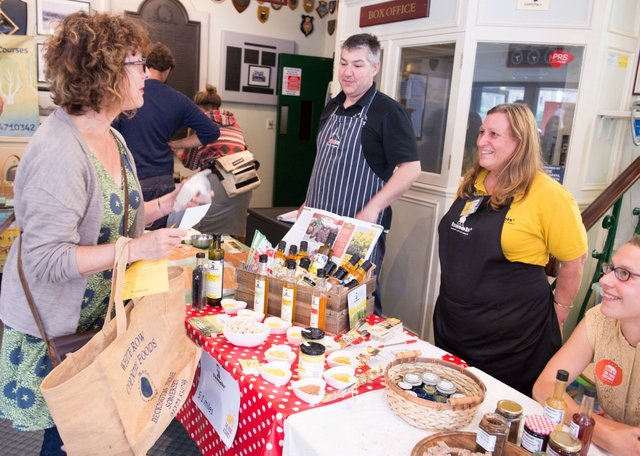Technology and empathy offer hope for the future of food

Hyperlink is produced by Winning Edits.
By Matthew Gartland
Our relationship with food is changing in ways we may not fully realize or understand. The Internet Age has given us instant connection to food sources, replete with options such as online grocery ordering and meal-in-a-box subscription services. And how we get our food isn’t the only variable in flux; what we get — the food choices themselves — is being disrupted by new technologies, services, incubators, and non-profit organizations just as much as the delivery mediums that ship those foods to our doorsteps.
Innovation in food science, food technology, food services, and food advocacy is brimming with hope — a hope for continued progress in areas such as food integrity, humane animal welfare, eco-friendly farming and raising, local farming and raising, efficacious supplements, awareness of sustainability efforts, alternative food market options, exposure to food prep and cooking skills, and so much more.
This hope for change and progress is fueling influential trends and shaping market shifts. Increasingly, consumers demand to know what substances they are putting into their bodies. Are the foods nutrient rich and free of pesticides, antibiotics, and genetically modified organisms (GMO)? What allergens may exist in those foods? And does the food producer care about the environment and how it’s contributing to the sustainability of the food economy for generations to come?
The demand for such information is no longer a luxury; in our Internet Age, providing such information is table stakes for anyone producing a food product or contributing to its distribution and consumption. Food options and ingredients can be searched on any mobile device in an instant from any grocery or restaurant. Consumers are blanketing social streams with pictures of what they’re eating in real time and whether or not they’d recommend it to their friends. Apps like Yelp and Foursquare encourage the rating of restaurants in large part based on the quality of their food. Ultimately, consumer demand for authentic food information and recommendations is a mainstream reality that food tech companies cannot and should not ignore.
This caliber of consumer demand has given rise to food tech startups that are pushing the limits of engineered food. Take, for instance, Clara Foods, a Silicon Valley venture capital-backed company that is working toward an advance in food technology by creating the world’s first animal-free egg white. Or look at the Food Assembly, a European organization with a vision to create a future where everyone has access to the pleasure of local food, and is connected to the people who grow it, raise it, and harvest it.
Don’t let the esoteric nature of such innovative food companies mislead you into thinking that the food tech sector is small and desolate, because it’s anything but. “The Internet of Food” has become a recognized, even a hot, opportunity that’s already attracted major investors willing to shill out big bucks. Blue Apron, the company that tech news site Recode describes as “the grocery startup that ships boxes of recipes and ingredients to the homes of wannabe chefs,” had raised nearly $200 million at a $2 billion valuation as of last October. And Impossible Foods, the company on a mission to convert meat lovers to plant-based meat burgers, has raised $182 million from investors that include Google Ventures and Bill Gates.
The food tech scene is so vast and diverse that venture capital database CB Insights organized major players in the industry into the following categories: next-gen foods, next-gen drinks, restaurant delivery, meals on-demand, office catering, meal kits, grocery delivery, speciality foods, farm-to-table, liquor on-demand, chefs on-demand.
While hope is a supercharger at the center of the food tech revolution and the influential trends and diversity born from it, a lesser known — yet more powerful — force is at the root of our relationship with food in these changing times.
That emotion: empathy.

xploring empathy for food in a world of UberEATS and Postmates may seem cognitively disjointed. But to food tech professionals like Mike Lee, highlighting and advocating empathy for food — and more so, the food system — is the game-changing pursuit we need as a society to prevent unintended societal and environmental costs that might plague our future.
Lee is the founder of the Future Market, a futurist food lab that explores the impact of food systems transformation on the food we eat over the next ten to fifty years. In his essay “Empathy for the Food System,” he writes that “In food, we’ve grown accustomed to the idea that products and services have been designed with our needs in mind.” He calls it a human-centric design disposition that favors the user over the system and, therefore, produces a condition where “. . . humans have mastered the art of bending food to our whims.”
To Lee, that expectation is inherently in conflict with the laws of nature, and lacking in the responsibilities progressive food designers should embrace. According to Lee, “as a society is able to successfully meet its core needs for food, it should have a responsibility to fulfill the goal of leaving the Earth better for the next generation.” One may interpret his perspective simply as a commitment to a sustainable and thriving relationship with food whenever and wherever a food choice must be made.
Lee’s may be a utopian point of view, but it could become a standard for everyone who thinks critically about their relationship with food. And as a new generation of food tech companies plows headlong into the next big idea, Lee’s perspective could also be a litmus test—one that can help these companies ensure alignment of their vision with the fundamental needs and constraints of a future global society.